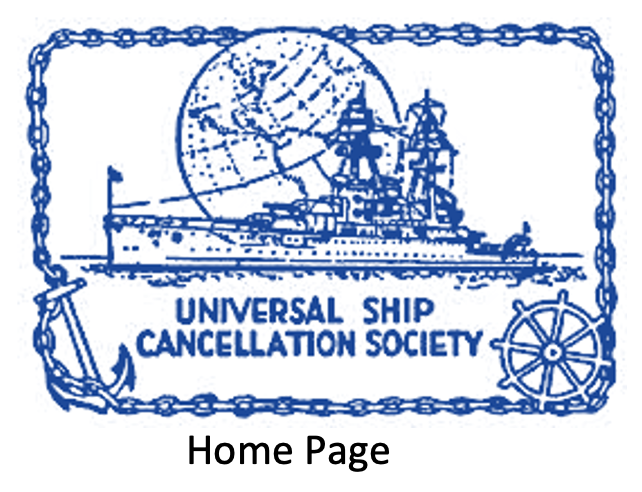Ahoy Matey! A Short History of U.S. Naval Covers
by John P. Young
During the 1930s, collectors of United States naval covers called their hobby “naval philately.” The first cover collectors were members of the International Postal Marking Society who sent stamped, addressed envelopes to U.S. Navy ships to obtain strikes of the ships’ postmarks.
Some famous pioneer collectors are Albert Gorman, Winfred Grandy, Lt. Cmdr. Francis Locy, USN, William Hornbeck and Walter “Bones” Crosby.
“Doc” Locy, a naval surgeon is known was developing in 1929 the classification system for U.S. Navy postmarks that is still in use today. The cancel types were modified slightly with the fifth edition of the Catalog of United States Naval Postmarks published in 1997 by the Universal Ship Cancellation Society. All referenes to cancellation types in this article are to the Locy system as modified in the 1997 catalog.
The basic part of a naval cancellation is the dater circle, called the “dial.” It has slots at the center for insertion of date slugs i.e. month, date, year & A.M. or P.M. The name of the ship or a generic U.S. Navy marking molded into the dater at the top or at the top and bottom.
To the right of the dial is the “killer”: three or four bars, a geometric pattern, or some wavy or straight lines used to cancel the stamp and prevent its reuse.
Some naval cover pioneers, namely Gorman, Grandy and Crosby are familiar to cover collectors from their production of first-day covers. Gorman, a retired Navy Department attorney used printed cachet for the 4 cents William H. Taft stamp (Scott #685) in figure 1. The cover was postmarked aboard the destroyer USS COLE (DD 130) on June 10, 1930, six days after the stamp’s first day of issue. The cover is over-franked by two cents.

“Win” Grandy, an early First Day cover sponsor used the 2 cents Red Cross stamp (Scout #702) on his cover mailed from USS MacLeish (DD 220), shown in figure 2. This postmark is unusual. The cover was postmarked using the ship’s type 3s cancel, with the top killer bar missing. Normally the date is inserted in the dial of the cancel, but for this cover, the date August 8, 1931, is provided by a straight-line date stamp struck inside the dater section of the cancellation.
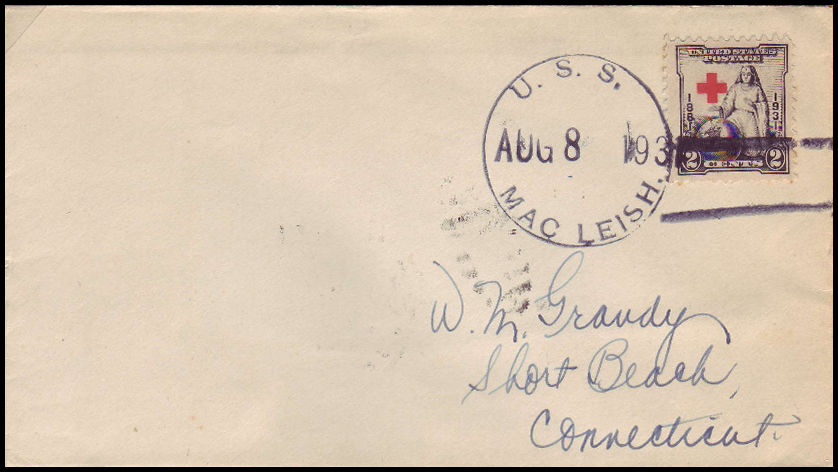
“Bones” Crosby, a retired Navy chief petty officer started collecting battleship cancels and became acquainted with many of the mail clerks aboard the battleships. The early cover from the mail clerk aboard USS UTAH (BB 31), shown in figure 3, was posted May 3, 1930. Jack Denison, the battleship’s mail clerk documents president-elect Herbert Hoover’s Good Will Cruise to South America with a four-line typed cachet. The cancels’ year is illegible, but the type 8 cancel (flag machine) indicates 1930 on the rear of the cover. Cover is franked with 2 cents Aeronautics stamp (Scott #649) that was issued in December 1928. Looks like Crosby’s cover was typed by him, wishing to obtain a cancel from UTAH on Hoover’s homeward bound cruise (18 DEC 1928- 6 JAN 1929.) Note: commas at the end of each typed line, usually found on Crosby’s addressed cover. It appears that his cover was eventually canceled 16 months later by Denison with the battleship’s type 3 cancel without inserting the correct year slot, probably because it was discarded in 1929.
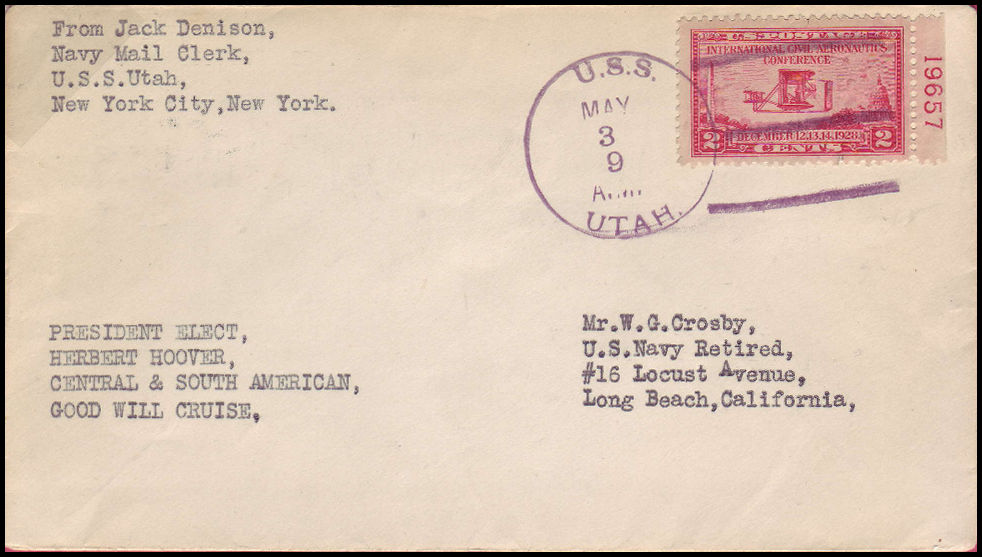
My favorite cover, showed in Figure 4, is addressed to Locy, himself. It is an unofficial first day cover of the 2 and 5 cents International Civil Aeronautics Conference stamps, Scott 649-50. The official first-day city was Washington, D.C. The cover, posted December 12, 1928 bears a type 5 cancel of Destroyer Squadron Nine, Scouting Fleet. Recently learned that the squadron’s type 5 cancel was used aboard the destroyer-tender, USS WHITNEY (AD 4). The cover was back-stamped with the received stamp and postal cancel of U.S. Naval Hospital. League Island (Philadelphia), PA. It bears a 1928 Christmas seal
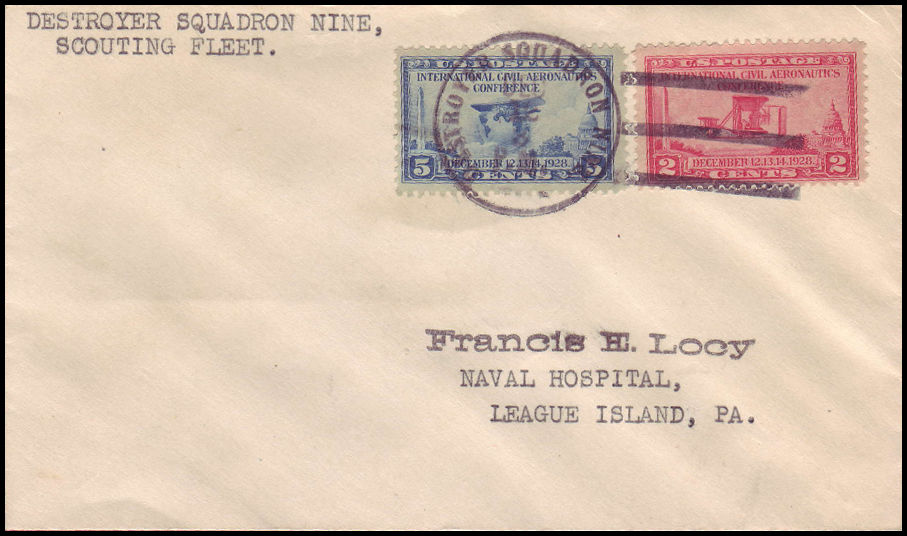
William Hornbeck, an early naval cover exhibitor (Minneapolis MN, 1928), was a film editor who lived in Hollywood CA. He sent for naval covers during the late 1920s and thanks to him and others, we have cancels from those post-World War 1 destroyers. Whenever I see the holiday standard It’s a Wonderful Life, I always think of Hornbeck. He was nominated for an Oscar for the best film editor at the 1946 Academy Awards. He didn’t that year, but took “Oscar” home in 1951 for A Place in the Sun.
Hornbeck used first-class postage on most his covers. For some unknown reason, he put his address on the left side of the envelope. In 1927-28, he liked to use the 2 cents White Plains stamp (Scott 629) on his covers. A rare exception was his use of the 1½ cents Warren Harding imperforate stamp, Scott 576. The 1½ cents stamp shown on figure 5 was posted aboard USS Mc FARLAND (DD 237) on February 18, 1928, while the destroyer was assigned to the Asiatic Fleet. For economy, many collectors used the 1½ cents stamp during the Great Depression. They would place an advertisement or a piece of newspaper inside an unsealed envelope so that it would qualify for the third-class rate, as printed matter. In some cases, the mail clerk would follow postal regulations that required at third-class mail cancellations be undated. However, it is rare to find such a cover without a date.
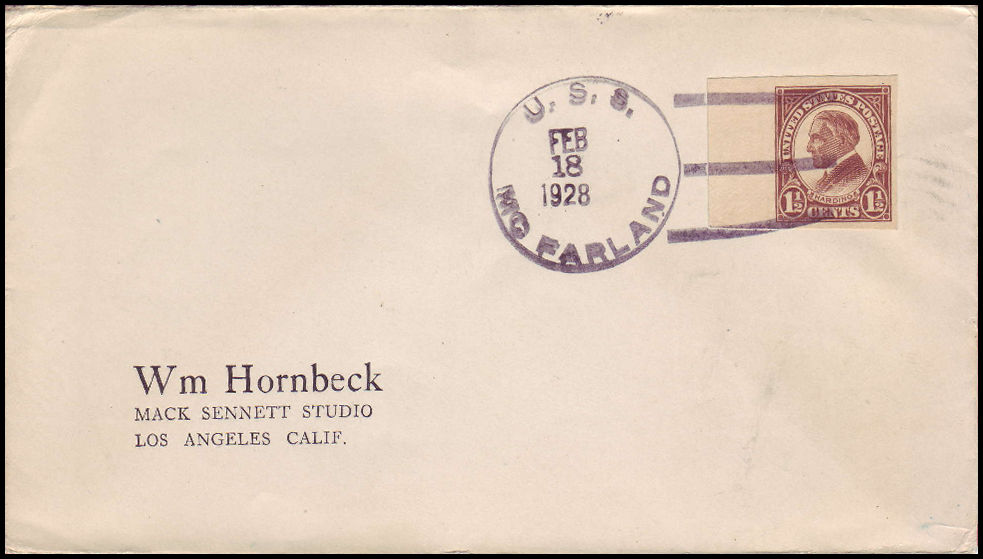
In September 1932, York Briddell and newspaperman, Alfred E. Newman started the Universal Ship Cancellation Society. By years end, Briddell had produced six bulletins for 49 USCS members. Each bulletin had information on ship movements and the names of some of the mail clerks assigned to the ships.
One mail clerk familiar to cover collector is Harry Moore, who canceled mail aboard the frigate USS CONSTITUTION during its famous 1931-34 cruise. Moore, who was later the mail clerk aboard USS TENNESSEE (BB 43), and was lost with USS LANGLEY (AV 3) on February 27, 1942, according to a notice in the ANCS Navigator. Note: research by Lloyd Ferrell found that Harry Moore survived the war and retired from the Navy in 1947. He died in January 1980. See USCS Log, October 2017
A rival group of naval cover collectors, the American Naval Cancellation Society was established in April 1935. Marshall Hall founded it, after he lost the 1935 USCS election to Dean Bartley.
Cachets depicting holidays and naval events began to appear during the early 1930s to enhance the appearance of covers. Hall took some of the best cachet sponsors with him when he bolted from the USCS. The ANCS formed crews who produced printed cachets and recruited Navy mail clerks for membership. Even FDR was given honorary membership. Most ANCS covers were often canceled aboard ships by member mail clerks.
Major cities such as Detroit, Honolulu, Philadelphia and Seattle all had a USCS chapter and an ANCS crew. New York City had the Farragut Chapter of the USCS, while ANCS members on the other side of the East River were known as the Brooklyn Crew.
The outbreak of World War II nearly sank the naval cover hobby when the Navy’s Chief of Naval Operations forbade the canceling of event covers for collectors. Prior to the war, Navy ships began using the type “Z” cancels for security reason. These cancels bore “U.S. Navy” in the dial rather than the ship’s name.
Collectors in both societies kept the hobby afloat by sending for covers for cancellations to Navy shore stations, which still showed the name of the installation in the cancel. They began to collect patriotic covers that were beings used by sailors on their letters home.
Today, the USCS remains very active, with more than 1,450 members and 25 chapters. The ANCS fell apart after several years of in-fighting among the officers. It disbanded during the Korean War, and much of their membership returned to the USCS fold. During the 1960s, the USCS began yearly conventions sponsored by local chapters. This period saw a renewed interest in naval covers because of space flights, polar explorations, and the building of nuclear submarines. USCS chapters and individuals including Morris Beck and Taze Nicholson produced covers with printed cachets for many building events, holidays and other naval events during the postwar years. Nicholson ran a cover service for more than six decades. The USCS publishes a monthly journal, the USCS Log, dedicated to the study of naval and maritime covers. The January issue contains the mailing addresses (Navy Zip Code) that enables collectors to send cover requests to ships. The journal has a monthly “For Beginning Members” that features helpful tips for new collectors. There are also regular columns devoted to foreign naval covers, submarine, and Coast Guard covers.
“Navo-philately” is a fascinating area. Even if you have no direct connection with the U.S. Navy, you might find a cover from your grandfather’s battleship, your father’s tin can (destroyer), your brother’s submarine or your sister’s aircraft carrier.
For more information about the Universal Ship Cancellation Society, write to USCS Secretary Steve Shay, 747 Shard Court, Fremont CA 94539 or visit the USCS website CLICK HERE to visit USCS Website
Published: Linn’s Stamp News, June 30, 2003 (updated 11/4/2020)
